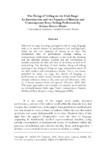Mostrar o rexistro simple do ítem
The Doing of Telling on the Irish Stage: An Introduction and two Samples of Modern and Contemporary Story-Telling Performativity
| dc.contributor.author | Herrero Martín, Rosana | |
| dc.date.accessioned | 2016-07-15T08:35:33Z | |
| dc.date.available | 2016-07-15T08:35:33Z | |
| dc.date.issued | 2008 | |
| dc.identifier.citation | AEDEAN 2008, 31: 733-743 ISBN-978-84-9749-278-2 | |
| dc.identifier.isbn | 978-84-9749-278-2 | |
| dc.identifier.uri | http://hdl.handle.net/2183/17086 | |
| dc.description.abstract | [Abstract] Delivered on stage, featuring a protagonist role on stage, language feels in its natural element of performance and transfiguration, which are the very elements of theatre at its best. The fundamental idea of performance (change dealing to surmounting) symbiotically embraces in fact both the theatrical and the narrative process. Conflict and the overcoming of conflict constitute the ebb and flow of all drama, as well as of story-telling. The blending of both modes, doing and telling, resulting in the doing of telling on stage, characterises much of the Irish modern and contemporary theatre. This is not theatre propelled by action on stage, but theatre of language in performance, in which central dramatic tension stems from the multiple imbalance between life, story and self (Morrison, 1983: 1), “a drama between body and speech” (Puchner, 2002: 169). This paper approaches two examples of narrative performativity on twentieth-century Irish stage: Yeats’s seminal piece Purgatory (1938) and Tom Murphy’s unique Bailegangaire (1985). | |
| dc.language.iso | eng | |
| dc.publisher | Universidade da Coruña | |
| dc.title | The Doing of Telling on the Irish Stage: An Introduction and two Samples of Modern and Contemporary Story-Telling Performativity | |
| dc.type | info:eu-repo/semantics/conferenceObject | |
| dc.rights.access | info:eu-repo/semantics/openAccess |






